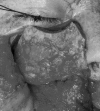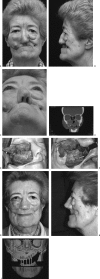Reconstruction of the maxilla with loss of the orbital floor and orbital preservation: a case for the iliac crest with internal oblique
- PMID: 20567711
- PMCID: PMC2884886
- DOI: 10.1055/s-2008-1081400
Reconstruction of the maxilla with loss of the orbital floor and orbital preservation: a case for the iliac crest with internal oblique
Abstract
Although many techniques have been described to reconstruct the midface and the maxilla, there remains little agreement on the most effective methods when the orbit itself is preserved but there is loss of the maxilla, orbital floor, and often the medial wall. If the principle of replacing form and function is to be preserved, then a complex three-dimensional bony shape is required, which can support the orbital floor and provide a functioning dentition through an implant-retained prosthesis. At the same time, the oral fistula must be closed and a nasal lining provided. The iliac crest with internal oblique provides a bone structure that can be shaped for the defect and can easily articulate with the malar remnant, the nasal bones, and the upper alveolus. The internal oblique muscle effectively closes the oral fistula and lines the nasal cavity and becomes epithelialized resulting in a natural appearance. This article describes the principles of use of the iliac crest with internal oblique in the reconstruction of this defect and compares this technique with the many other methods reported in the literature. The article is mainly descriptive as there are few comparative studies comparing reconstructive techniques for a similar defect.
Keywords: Maxilla; iliac crest; reconstruction.
Figures





Similar articles
-
Deep circumflex iliac artery free flap with internal oblique muscle as a new method of immediate reconstruction of maxillectomy defect.Head Neck. 1996 Sep-Oct;18(5):412-21. doi: 10.1002/(SICI)1097-0347(199609/10)18:5<412::AID-HED4>3.0.CO;2-8. Head Neck. 1996. PMID: 8864732
-
Modifications of the deep circumflex iliac artery free flap for reconstruction of the maxilla.J Plast Reconstr Aesthet Surg. 2015 Aug;68(8):1044-53. doi: 10.1016/j.bjps.2015.04.028. Epub 2015 May 23. J Plast Reconstr Aesthet Surg. 2015. PMID: 26051851
-
Orbital Floor Reconstruction: 3-Dimensional Analysis Shows Comparable Morphology of Scapular and Iliac Crest Bone Grafts.J Oral Maxillofac Surg. 2018 Sep;76(9):2011-2018. doi: 10.1016/j.joms.2018.03.034. Epub 2018 Mar 28. J Oral Maxillofac Surg. 2018. PMID: 29679587
-
Iliac crest internal oblique osteomusculocutaneous free flap reconstruction of the postablative palatomaxillary defect.Arch Otolaryngol Head Neck Surg. 2001 Jul;127(7):854-61. Arch Otolaryngol Head Neck Surg. 2001. PMID: 11448363
-
The iliac crest microsurgical free flap in mandibular reconstruction.Clin Plast Surg. 1994 Jan;21(1):37-44. Clin Plast Surg. 1994. PMID: 8112011 Review.
References
-
- Brown J S, Rogers S N, McNally D N, Boyle M. A modified classification for the maxillectomy defect. Head Neck. 2000;22:17–26. - PubMed
-
- Coleman J J, III, Coleman J J. Microvascular approach to function and appearance of large orbital maxillary defects. Am J Surg. 1989;158:337–341. - PubMed
-
- Futran N D, Futran N D. Primary reconstruction of the maxilla following maxillectomy with or without sacrifice of the orbit. J Oral Maxillofac Surg. 2005;63:1765–1769. - PubMed
-
- Genden E M, Okay D, Stepp M T, et al. Comparison of functional and quality-of-life outcomes in patients with and without palatomaxillary reconstruction: a preliminary report. Arch Otolaryngol Head Neck Surg. 2003;129:775–780. - PubMed
-
- Rogers S N, Lowe D, McNally D, et al. Health-related quality of life after maxillectomy: a comparison between prosthetic obturation and free flap. J Oral Maxillofac Surg. 2003;61:174–181. - PubMed

